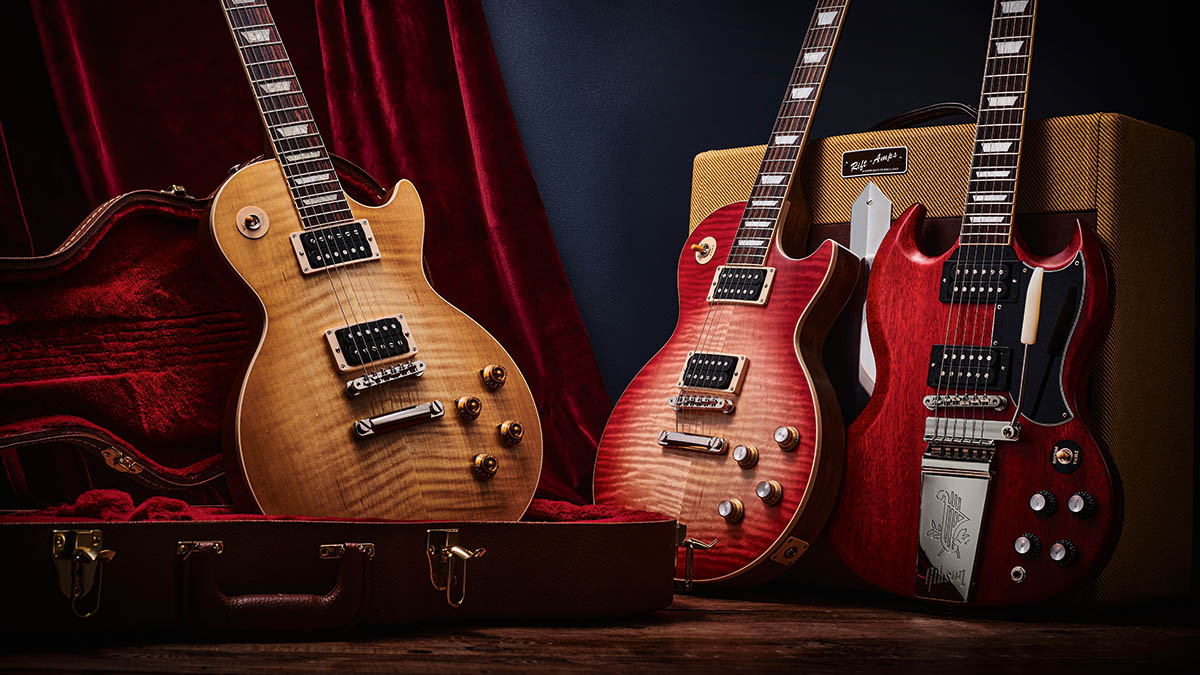Guitar World Verdict
On the one hand there’s a raw, stripped vibe to the Les Pauls that shouts ‘gig me’, but to be honest there’s a more boutique-like vibe going on here. The SG looks much more normal, of course, with its cherry-over-mahogany shade, and while the LPs are good, it’s this beautifully delicate instrument that stands out.
Pros
- +
Excellent builds.
- +
Vibrant ‘raw’ voicing.
- +
50s LP and the SG are a good weight.
- +
Slim neck profile on the 60s LP.
- +
Very good example of an early SG.
Cons
- -
No colour options.
- -
Fingerboard binding is a little sharp-edged on the SG.
You can trust Guitar World
Since coming under new ownership in late 2019, the good ship Gibson is now very much back on track, making some of the best guitars we’ve seen for many a year.
With a focus on quality and consistency, the uptake on the new-spec models from the standard Gibson USA lines – not to mention the ‘pandemic effect’ – has meant new models have been scarce. Until now, with the release of three new Faded electric guitars you see here, and three acoustic guitars that we’ll review in due course.
“The original run of Les Paul Standard Faded models began shipping in 2005 and shipped into 2009,” clarifies Lee Bartram, Gibson EU’s head of marketing and cultural influence. “There have been some similar limited runs since. Over the years the Faded models have built up an amazing reputation, so we are bringing the Faded line-up back: the fan favourite is back.”
Part of the appeal of the original Faded concept was the more simple satin ‘worn’ finishes – a faster manufacturing process – that allowed a lower price. But these new models seem to have a slightly different aim.
“When the original Faded series debuted in 2005, the idea was to create a very vintage vibe without a glossy finish while streamlining some of the specs,” continues Lee. “Players and collectors took to them because of the vintage look and because they provided the perfect platform for modification and historic parts upgrades. The finish of those original-run instruments was intended to have a worn look, but this time we did not want to break the lacquer – just provide the vintage vibe.”
Concept and finish aside, the specification of these three new models is very similar to the gloss-finish models we’ve been seeing since late 2019.
Les Paul Standard 50s & 60s Faded
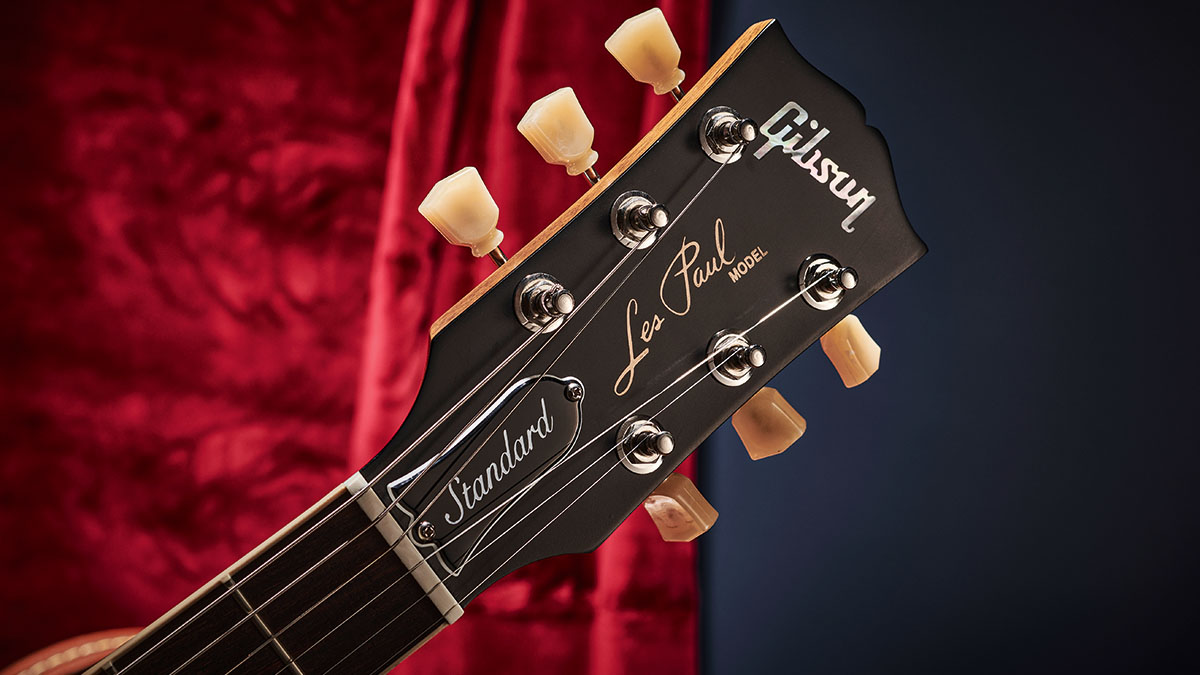
Along with minor details such as the absence of pickup covers and pickguards on these Les Pauls (which will be included as case candy), the major difference is the au naturel satin nitro finish, and there’s just the single colour for each that you see here.
Our 50s Les Paul Standard is spec’d with a Honey Burst finish, although there’s precious little colour to the stained top. Our 60s Vintage Cherry Sunburst has some deeper red colour but looks positively anaemic next to our much more richly hued 2019 Les Paul Classic reference in its Heritage Cherry Sunburst.
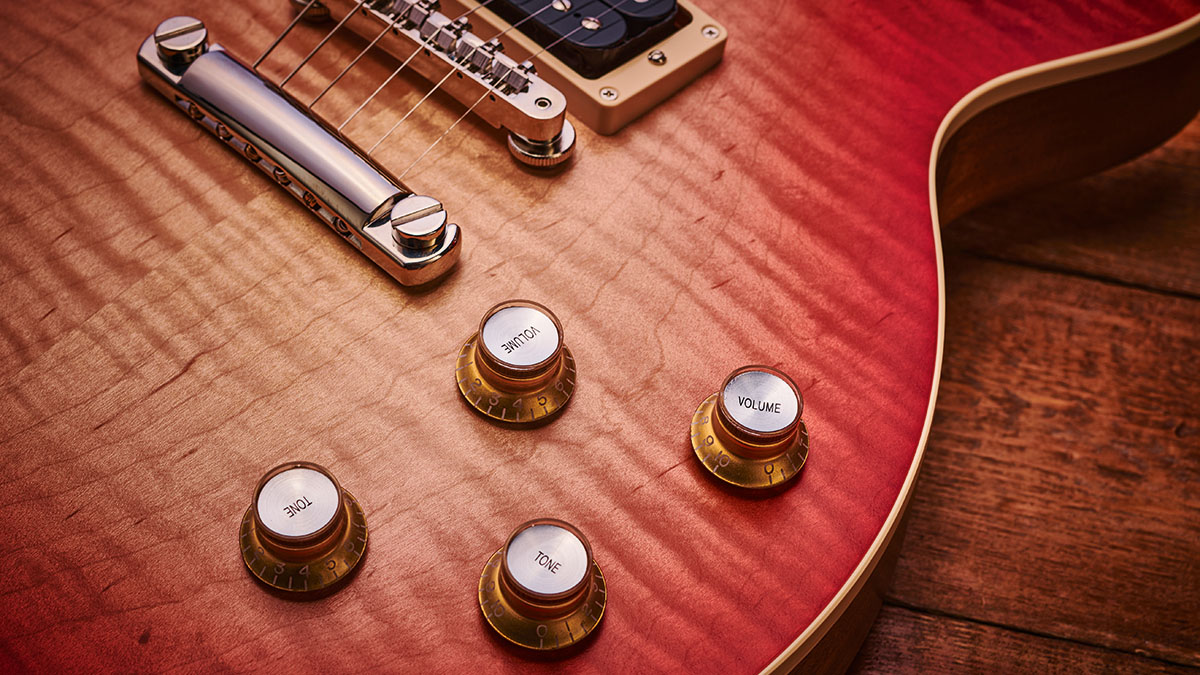
Both have AA-grade flamed tops with bold striped figure and a few ‘dirty’ flecks: classic Gibson. Tops aside, the rest of the mahogany body and neck backs have the same thin finish, albeit with what appears to be a light walnut stain or grain-filler rubbed on.
As we’ve said many times before, a natural finish leaves nowhere to hide, so any tooling marks or gaps in joints are instantly visible. And perhaps this Faded concept is another way to remind people that Gibson really has its act together. Outwardly at least, the craft is excellent.
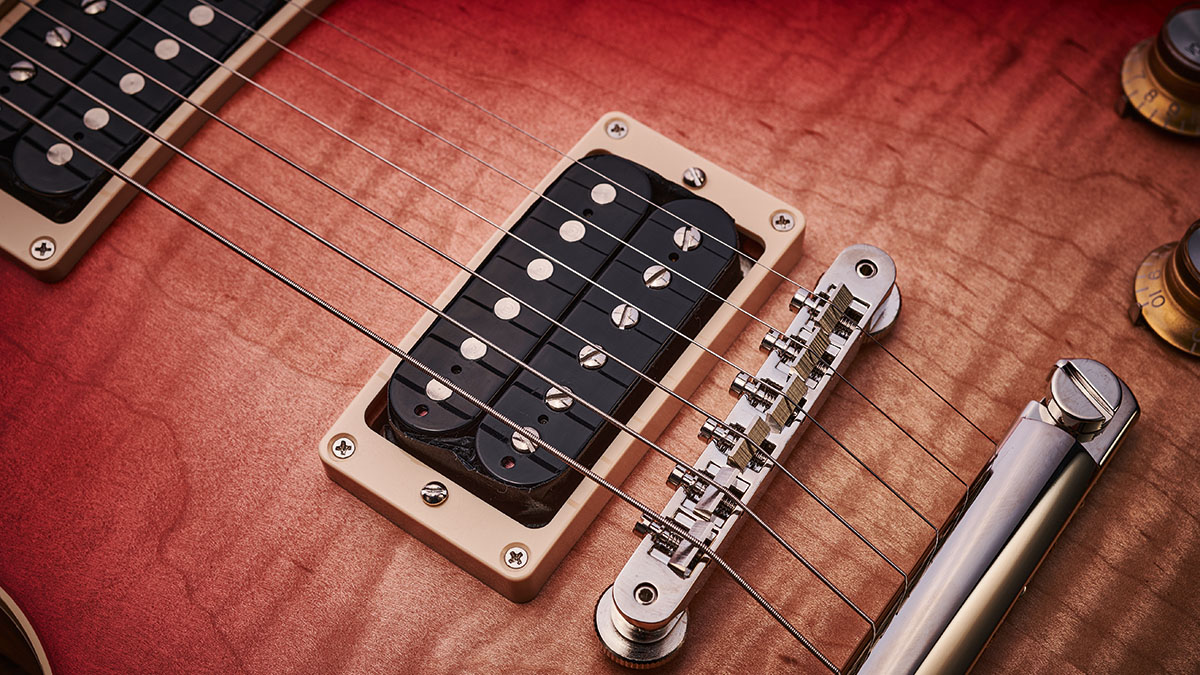
The two-piece bodies are immaculately centre-joined, and without any weight relief aren’t over-heavy (although the 60s LP is the weightiest), while neck angles on all three appear very consistent. Little if any actual grain filler is used, which is most evident on the ‘open pore’ appearance of the SG; both Pauls are very slightly smoother feeling to the touch.
The top edge binding on the Les Pauls is left a little sharp, likewise the fingerboard binding, which does give the impression these were grabbed off the production line with effectively just a sealer finish and sent directly to assembly.
Aside from different pickup specs and the fuller neck carve of the 50s, it’s only the tuners that differ: the 50s goes for vintage-style Gibson Deluxe types; the 60s has Grover Rotomatics – just like the standard gloss-finish models.
SG Standard ’61 Faded Maestro Vibrola
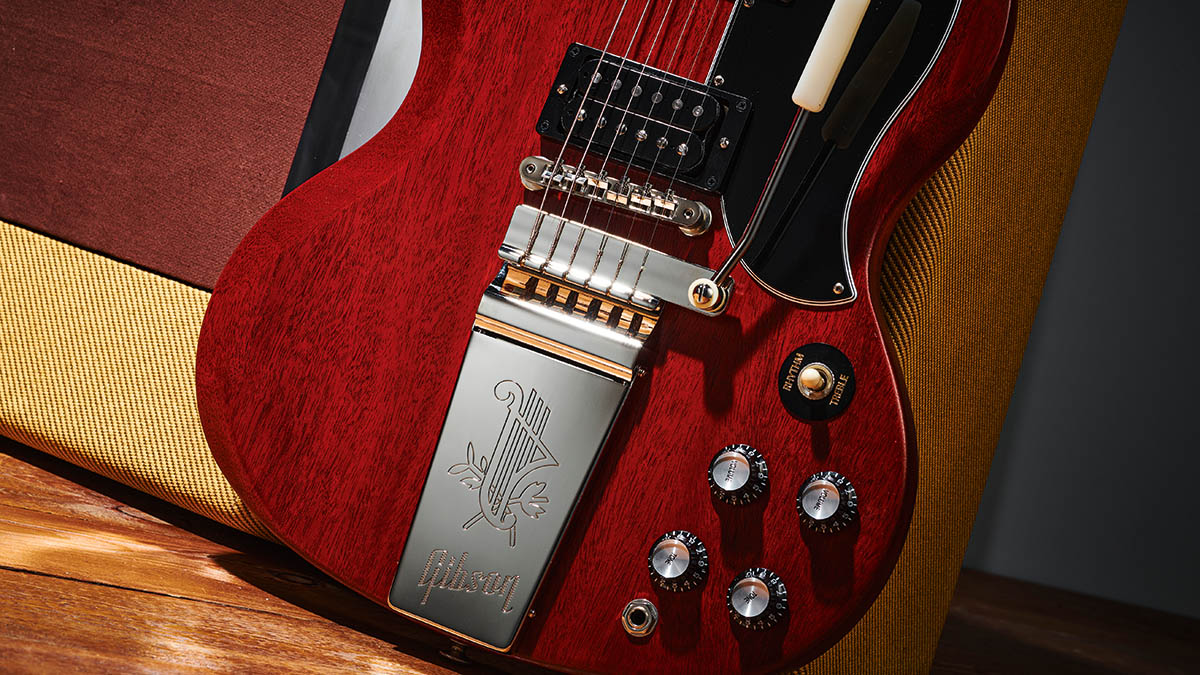
The Faded trio is completed by an all-mahogany Cherry SG and at least this has some depth to its colour, which is applied to the whole body and neck. It is rather oddly named as this would still have been a Les Paul Standard in 1961; it didn’t become ‘SG’ until later, in 1963, after Les and Gibson had parted company.
A ’61 Les Paul/SG would have also featured the sideways Vibrola – most famous, basically, for not working. Thankfully, the later long Vibrola is fitted here and that works just fine.
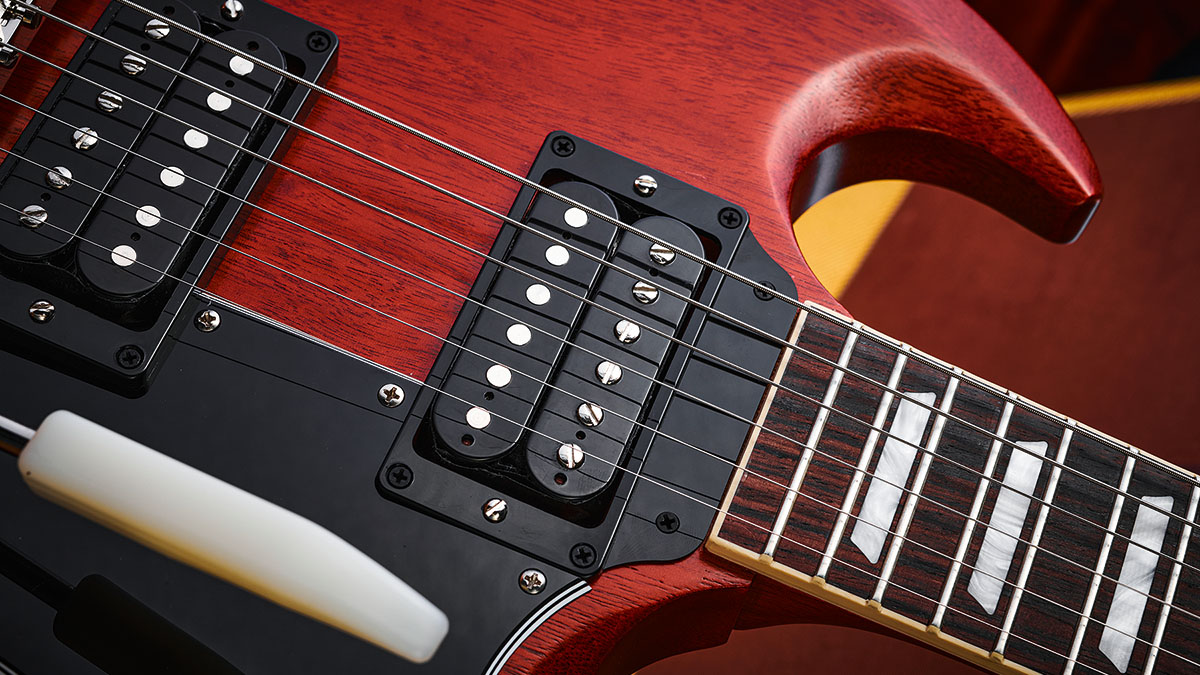
“The ’61 SG is a long-standing model at Gibson USA, made for over 30 years,” Lee Bartram tells us. “It is also the best-selling model in that time, so we didn’t want to change the nomenclature, rather offer it as fans knew it. And calling it an ‘SG Standard 60s’ wouldn’t make sense because of the different specs and pickguard styles used in that range.”
What can’t be disputed is the change in design compared with the original Les Paul, which is massive. The Les Pauls’ depth was 50mm at the rim with an overall depth of 61mm at the apex of the carved top, while the slab body here is thin at 34mm, the famous edge chamfering making it seem even thinner.
Many high-end makers use a ‘hand-rubbed’ satin finish, a bare wood or rubbed-through style for the neck backs, and these feel very similar – they’re smooth yet slightly tactile
The neck joins the body at the 22nd fret and, aside from the small heel, it is completely unsupported along its length, as opposed to the Les Paul’s 16th fret neck to body join.
The quarter-sawn mahogany used for the neck does result in a pretty stiff structure with little flex – not always the case with SGs – although, again, that edge binding to the rosewood ’board is crying out for a little final sanding to smooth the ledges on either side.
Neck profile and pickups are the same as the 60s Les Paul, but we have those vintage-style Gibson Deluxe tuners of the 50s here.
Feel & Sounds
The oh-so-new feel of the guitars may be a little alien, but there is also a whiff of small-’shop boutique construction style. For example, many high-end makers use a ‘hand-rubbed’ satin finish, a bare wood or rubbed-through style for the neck backs, and these feel very similar – they’re smooth yet slightly tactile.
As with the standard models, the 50s neck here is the fullest: 22mm deep at the 1st fret, 24.9mm by the 12th – a small finish thickness away from the previous 50s Standard.
Of course, the difference in feel between the Les Pauls and the SG is marked. You can only imagine what Les Paul would have said back in the day when Ted McCarty handed him one of these!
The 60s drops to 20.7mm at the 1st fret and 23.7mm by the 12th – again, very close to the fully finished 60s Standard and Classic of that previous review. These SlimTaper profiles have a slightly flatter back but still keep the relaxed shoulders.
The SG’s neck actually feels a little asymmetrical with more shoulder on the bass side. It also has that slight ledge where the finish has been scraped from the binding. While that might take a while to wear in, even after our relatively short test time it’s the SG’s finish that is most notably beginning to slightly burnish to a subtle gloss.
The fretwire feels pretty classic, too, as it’s relatively low and medium in width. Like those binding edges, a little more polishing to the fret tops would add some slinkiness, but the setups are consistent and we really have zero problems here.
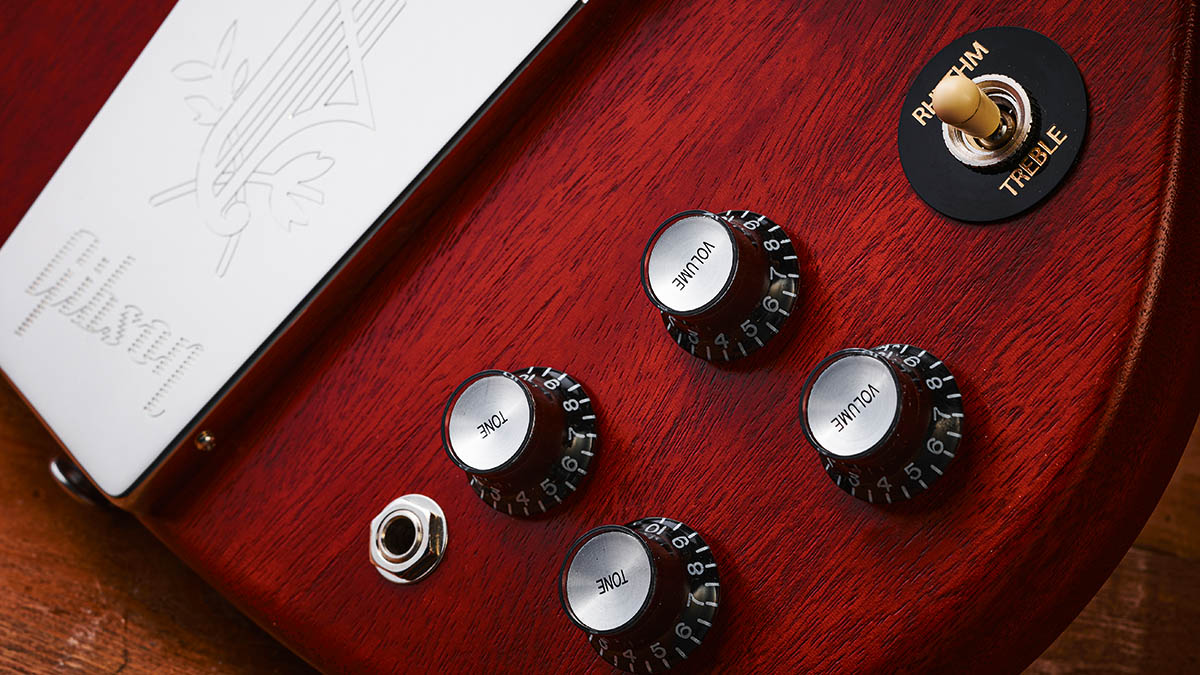
Of course, the difference in feel between the Les Pauls and the SG is marked. You can only imagine what Les Paul would have said back in the day when Ted McCarty handed him one of these!
The neck seems extended, then there’s that thin body depth, the pointed horns and a very different, lighter weight. Yet its delicate feel is very endearing, along with a lovely ring and sustain that’s enhanced with some light waggle from the Vibrola.
There is a slight neck-pull strapped on, plus the heel-placed strap button means that the guitar tips forward a little. But with the right strap it’s all easy to manage, the light weight compensating in spades.
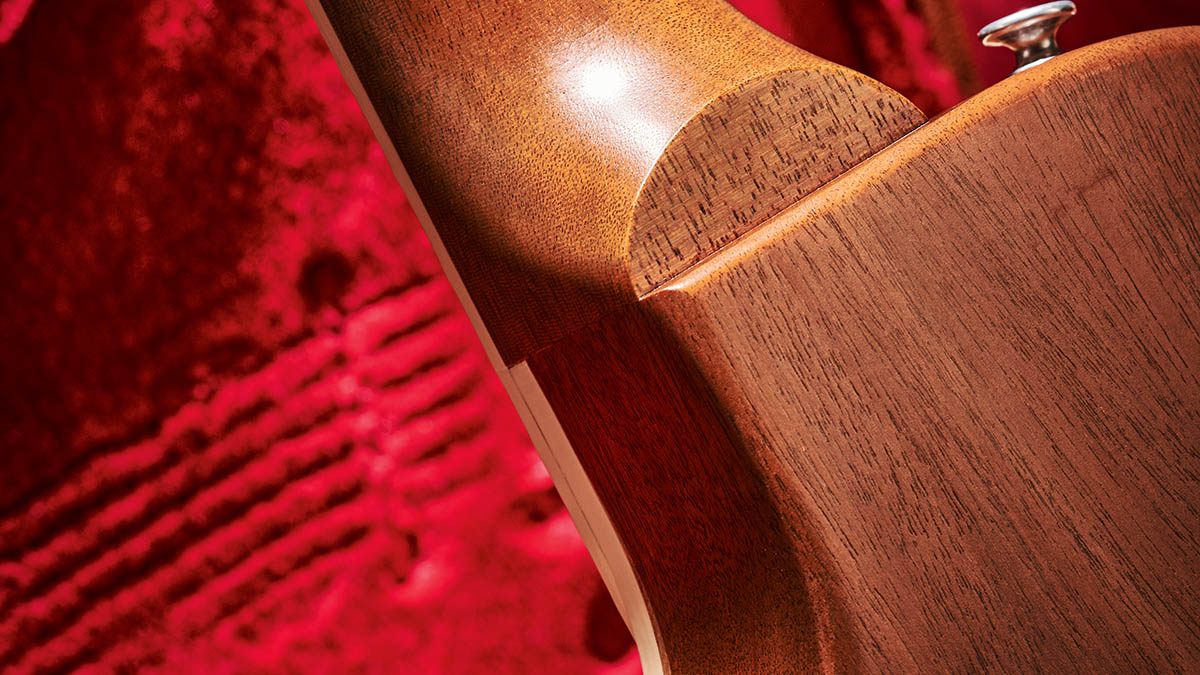
Pickup position will play a part in what we hear. The screw coil of the LP’s bridge pickup sits 596mm from the face of the top nut; the SG’s is 598mm – very similar. But the centre of the screw coil of the neck pickup on the Les Paul is 474mm, as opposed to the SG’s 489mm measurement: closer to the bridge to allow more wood in that neck joint, with the gap covered with a plastic plate.
To narrow the gap as best we could, we set all the humbuckers 1/16th inch from the top string on the treble side, fretted at the last fret, and 3/32nds on the bass side. Let’s plug in…
Finish can have a dampening effect on what you hear, so the lack of it here seems to give slightly more crispness to the high-end response; likewise the absence of pickup covers.
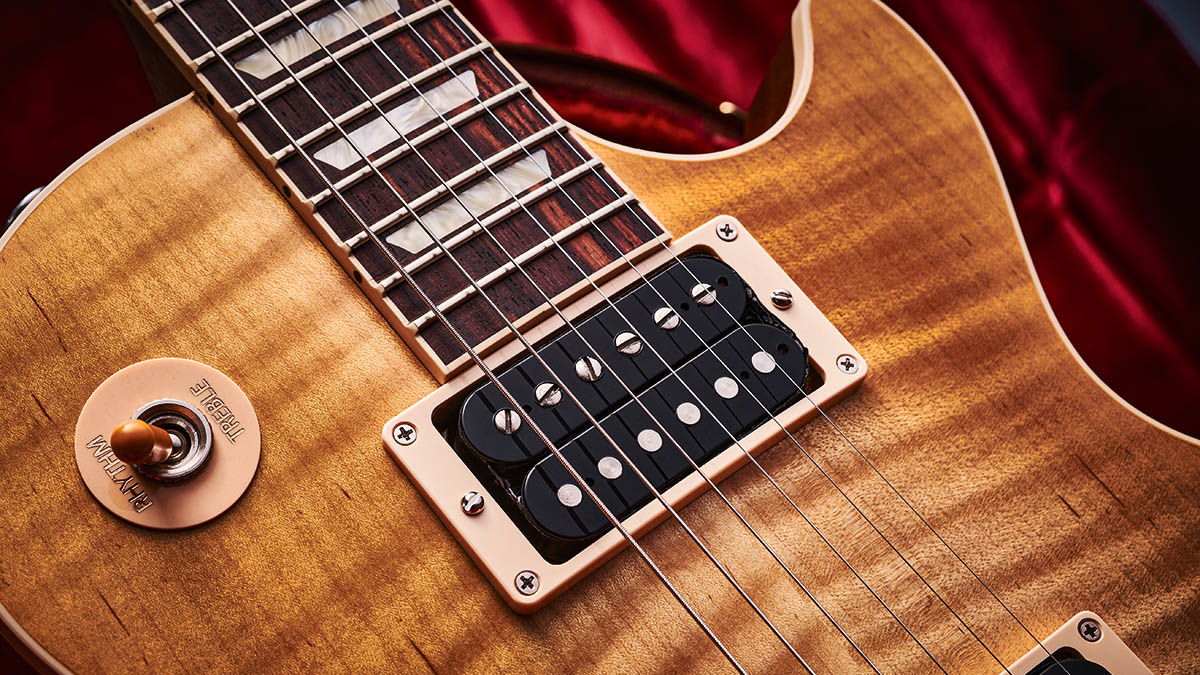
Our Les Paul Classic reference (retrofitted with covered and unpotted Burstbuckers 1 and 2) sounds a little more rounded and smoother in the high-end, but it’s also been a guitar for a lot longer than either of these Faded models and played a lot.
Like any modern version of the PAF, Burstbuckers have their fans and detractors. They’re relatively low in output, and there’s a beautiful old-blues ‘honk’ to the 2 at the bridge with a smooth but clean response from the 1 at the neck. Plugging in the 60s with its 61 pair – which both have very similar outputs – there’s slightly more high-end presence and perhaps a slight scoop to the mids, but they’re in a very similar ballpark.
The SG does sound more different, seemingly with less highs and lows but such a sweet juicy voice, especially when we begin to add some crunch and volume. The slightly closer placement of the pickups creates the most Fender-y mixed position, and overall there’s a lovely vintage-y character, too. It’s the sum of its parts, for sure, but 61 years on, the SG has earned its stripes on countless stages and classic recordings – and this one is a beaut.
Verdict
While these new Faded models might simply be an opportunity for Gibson to offer guitars that are slightly reduced in price (by around 11 per cent) when compared with the fully finished equivalent models, they neither feel nor sound like instruments Made In Hurry.
On the one hand there’s a raw, stripped vibe to the Les Pauls that shouts ‘gig me’, but to be honest there’s a more boutique-like vibe going on here. The SG looks much more normal, of course, with its cherry-over-mahogany shade, and while the LPs are good, it’s this beautifully delicate instrument that stands out.
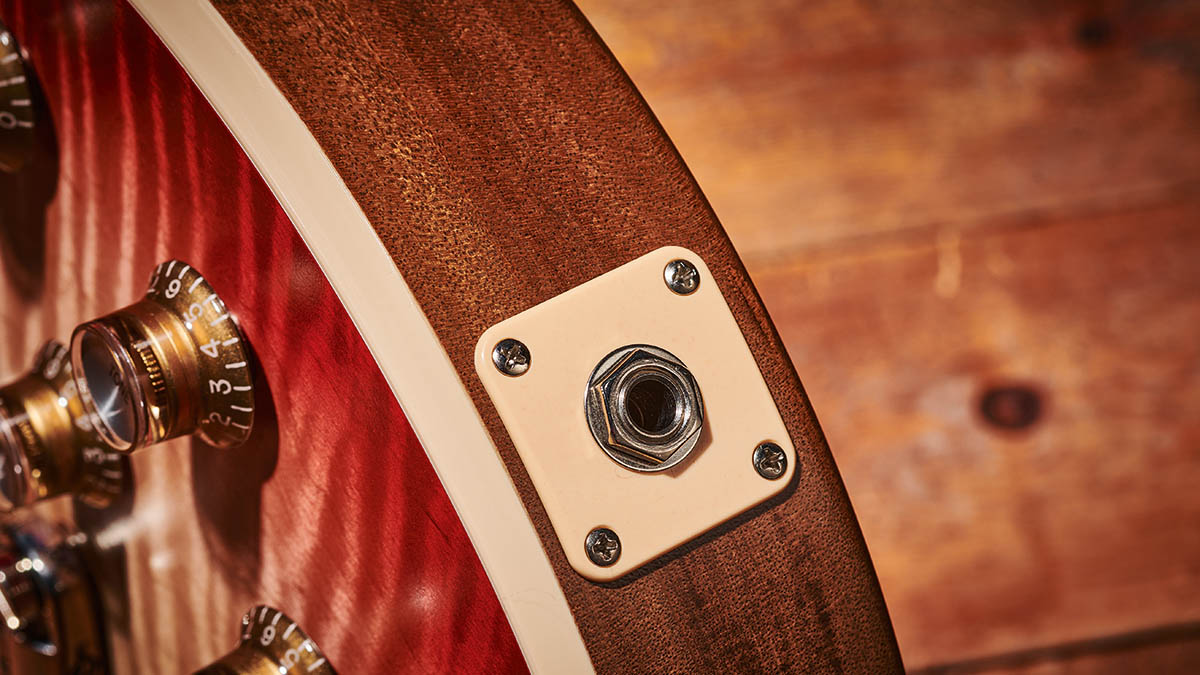
But we have to be realistic, don’t we? Not everyone is going to get on with the colours of the Les Pauls – and that price reduction is unlikely to cover the price of a professional refinish. And while many of us enjoy our modding adventures, you’re going to need to be pretty confident before you start work on a $/£2k guitar.
So there’s plenty to consider and there are a few sharp unfinished edges, but sound-wise this trio is superb. Finished, unfinished? Well, you now have a choice, and anyone who thinks that Gibson isn’t making great guitars once more really needs to think again.
Specs
Gibson Les Paul Standard 50s Faded
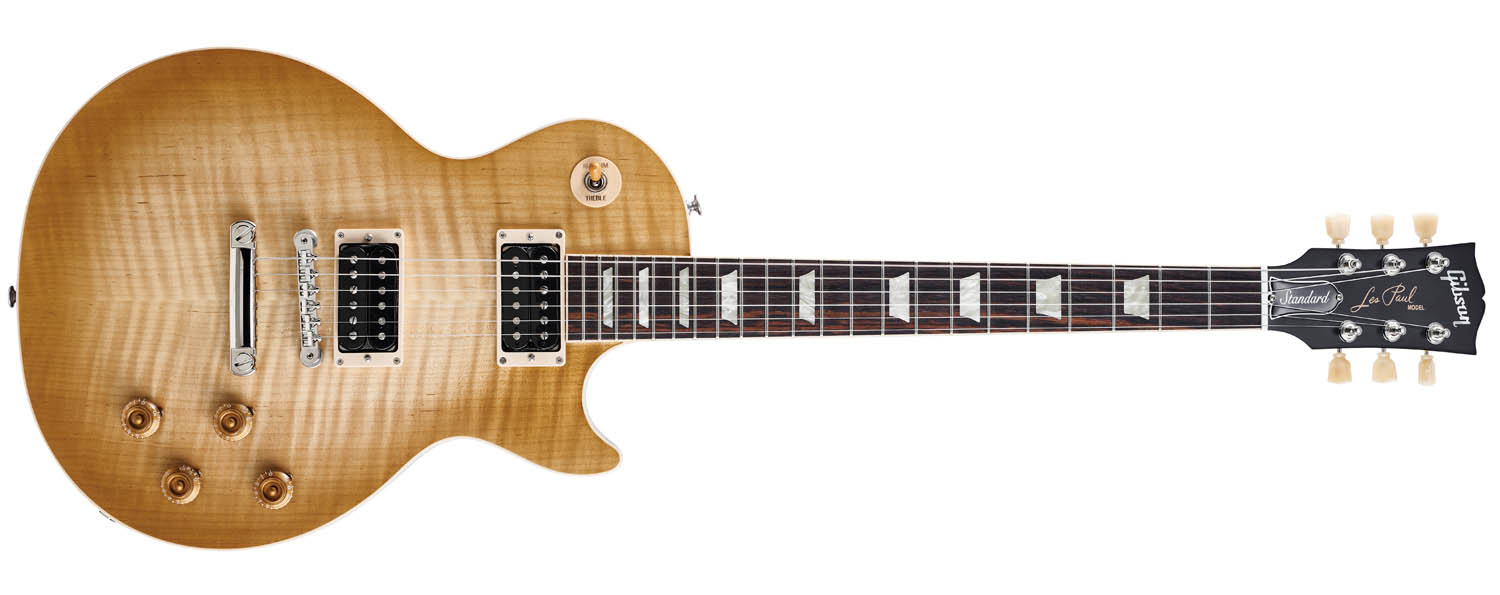
- PRICE: $2,499 / £2,169 (inc case)
- ORIGIN: USA
- TYPE: Single-cutaway, solidbody electric
- BODY: 2-piece mahogany with carved AA figured maple top
- NECK: 1-piece mahogany, Vintage 50s profile, glued-in
- SCALE LENGTH: 624mm (24.6”)
- NUT/WIDTH: Graph Tech/42.61mm
- FINGERBOARD: Single-bound rosewood, Acrylic Trapezoid inlays, 305mm (12”) radius
- FRETS: 22, medium jumbo
- HARDWARE: ABR-1 tune-o-matic bridge, aluminium stopbar tailpiece, Vintage Deluxe tuners w/ keystone buttons – nickel‑plated
- STRING SPACING, BRIDGE: 51.5mm
- ELECTRICS: Uncovered Gibson Burstbucker 1 (neck) and Burstbucker 2 (bridge), 3-way toggle pickup selector switch, volume and tone for each pickup
- WEIGHT (kg/lb): 3.96/8.71
- RANGE OPTIONS: The fully glossed finish Les Paul Standard 50s costs £2,429; the Les Paul Classic is £2,169
- LEFT-HANDERS: No
- FINISH: Honey Burst (as reviewed) – satin nitrocellulose
Gibson Les Paul Standard 60s Faded
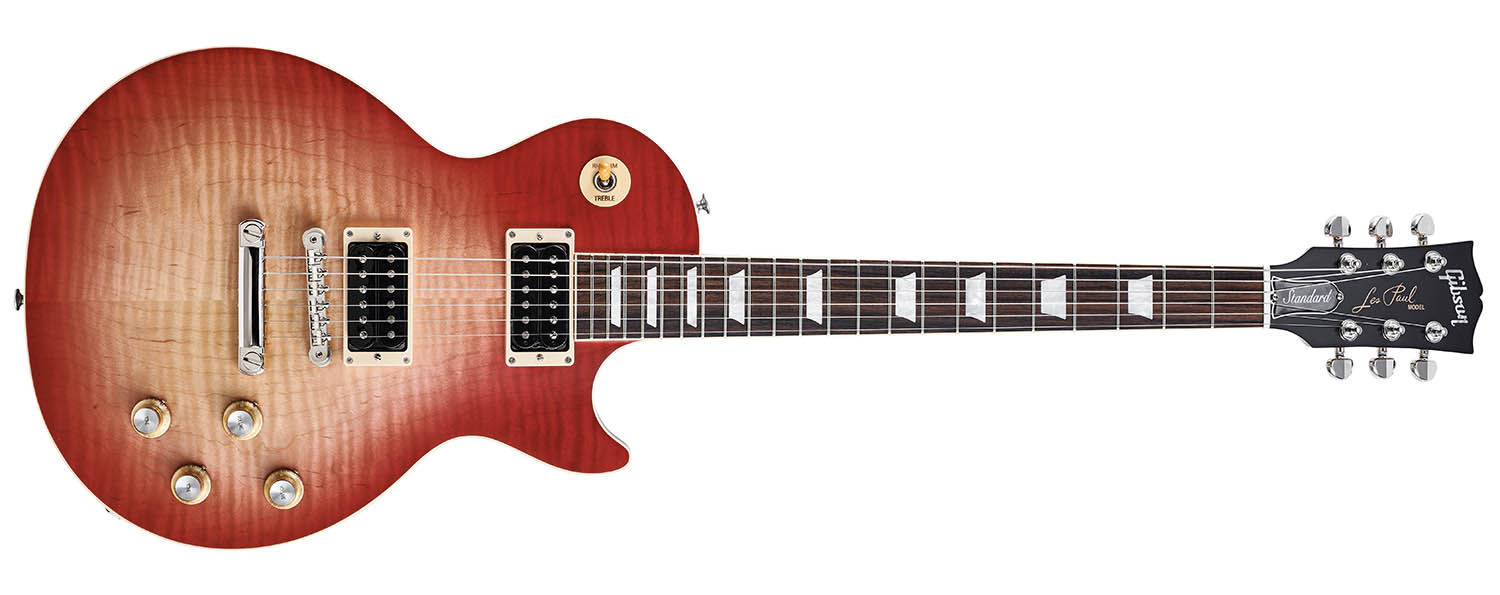
- PRICE: $2,499 / £2,169 (inc case)
- ORIGIN: USA
- TYPE: Single-cutaway, solidbody electric
- BODY: 2-piece mahogany with carved AA figured maple top
- NECK: 1-piece mahogany, SlimTaper profile, glued-in
- SCALE LENGTH: 624mm (24.6”)
- NUT/WIDTH: Graph Tech/42.82mm
- FINGERBOARD: Single-bound rosewood, Acrylic Trapezoid inlays, 305mm (12”) radius
- FRETS: 22, medium jumbo
- HARDWARE: ABR-1 tune-o-matic bridge, aluminium stopbar tailpiece, Grover Rotomatic tuners w/ kidney buttons – nickel-plated
- STRING SPACING, BRIDGE: 51.5mm
- ELECTRICS: Uncovered Gibson Burstbucker 61R (neck) and Burstbucker 61T (bridge), 3-way toggle pickup selector switch, volume and tone for each pickup
- WEIGHT (kg/lb): 4.25/9.35
- RANGE OPTIONS: The fully glossed finish Les Paul Standard 60s costs £2,429
- LEFT-HANDERS: No
- FINISH: Vintage Cherry Sunburst (as reviewed) – satin nitrocellulose
Gibson SG Standard ’61 faded Maestro Vibrola

- PRICE: $2,199 / £1,899 (inc case)
- ORIGIN: USA
- TYPE: Double-cutaway, solidbody electric
- BODY: 2-piece mahogany
- NECK: 1-piece mahogany, SlimTaper profile, glued-in
- SCALE LENGTH: 624mm (24.6”)
- NUT/WIDTH: Graph Tech/42.69mm
- FINGERBOARD: Single-bound rosewood, Acrylic Trapezoid inlays, 305mm (12”) radius
- FRETS: 22, medium jumbo
- HARDWARE: ABR-1 tune-o-matic bridge, Maestro Vibrola tailpiece, vintage deluxe tuners w/ keystone buttons – nickel-plated
- STRING SPACING, BRIDGE: 51.5mm
- ELECTRICS: Uncovered Gibson Burstbucker 61R (neck) and Burstbucker 61T (bridge), 3-way toggle pickup selector switch, volume and tone for each pickup
- WEIGHT (kg/lb): 3.96/8.71
- RANGE OPTIONS: The fully glossed finish SG Std ’61 Maestro Vibrola costs £2,089; the hardtail SG Standard ’61 is £1,739
- LEFT-HANDERS: No
- FINISH: Vintage Cherry satin (as reviewed) – satin nitrocellulose
- CONTACT: Gibson

Dave Burrluck is one of the world’s most experienced guitar journalists, who started writing back in the '80s for International Musician and Recording World, co-founded The Guitar Magazine and has been the Gear Reviews Editor of Guitarist magazine for the past two decades. Along the way, Dave has been the sole author of The PRS Guitar Book and The Player's Guide to Guitar Maintenance as well as contributing to numerous other books on the electric guitar. Dave is an active gigging and recording musician and still finds time to make, repair and mod guitars, not least for Guitarist’s The Mod Squad.
“It holds its own purely as a playable guitar. It’s really cool for the traveling musician – you can bring it on a flight and it fits beneath the seat”: Why Steve Stevens put his name to a foldable guitar
“Finely tuned instruments with effortless playability and one of the best vibratos there is”: PRS Standard 24 Satin and S2 Standard 24 Satin review
